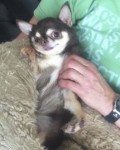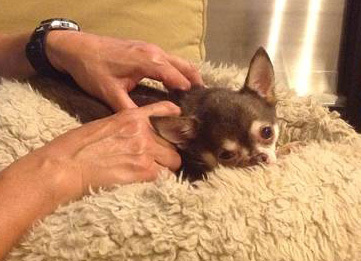Nancy Zidonis's Blog, page 4
September 29, 2014
Equine Acupressure – Retained Placenta
By: Tallgrass Animal Acupressure
The birth of a foal is an amazing event. If all goes well, the mare proceeds through three stages of labor relatively quickly. Stage one generally involves overall restlessness as the mare paces the stall, paws, lies down, gets back up, and often begins to sweat. In stage two there are strong contractions, “breaking of the water” occurs, and the mare may lie down to deliver the foal, often in a just a few minutes.
Once the foal is safely delivered there is still more to be done. In Stage three of labor the placental membranes are expelled and it is highly important that placental membranes are expelled completely.
Placental expulsion occurs as the mare continues with strong, labor-like uterine contractions. Generally, placental expulsion takes place within one to three hours after birth, but on occasion some or all of the placenta is retained. The only way to know for sure if the entire placenta has been expelled is to examine it closely after expulsion. If tears have occurred and pieces seem to be missing, there is a likelihood that some of it remains within the uterus.
Clearly, this medical situation is part of your holistic veterinarian’s mare and foal care protocol. The determination of retained placenta should be made by your veterinarian.
When a foal of mine was born several years ago our veterinarian determined that our mare, Mariah, likely had some level of retained placenta. About 3 hours after birth, I worked the equine acupressure points shown in the following chart with success!

August 24, 2014
Canine Acupressure: How to Work with a Difficult Dog
By Gretchen Dietz
The first words out of Bob’s mouth aren’t nice ones. If he had thought bubbles, they’d be censored. An 8-year-old Chihuahua, scurries across the living room paddling his crippled and unusable left front leg while tossing his small head back in a fit of angry commentary. It’s been this way since I met Bob… almost two years ago!
Bob was rescued as a puppy and while his legs weren’t nearly as deformed as they are now (particularly the left front), his body has always been slightly contorted and in much need of body work. The only problem has been that no one could get near Bob. He’d snap. He’d charge. He’d bite. And yes, he barked – incessantly and loudly.
Working with difficult dogs is a bit like solving a puzzle. Every dog is different and every difficult dog is particularly different when it comes to touch. Understanding body language helps a great deal as does a heavy dose of patience. With Bob, I didn’t attempt to touch him at first. Instead, his owner placed him in his bed and placed the bed on my lap. I sat with him, my hands by my side, and never gave direct eye contact. I yawned occasionally, asked permission to touch him, and just waited for a sign that he was ready.
The first touch was to his lower back, partly because that was the area doing all the work given his crippled front body, but also to protect myself from being bitten. I didn’t really know what to expect, but to my surprise, Bob pushed into my hand and remained there.
 Of course, the next session he growled and snapped at me when I reached for his back so again I waited, I yawned, I asked permission, and soon he shimmied up sideways and leaned his belly into mine. To my surprise, I spent the session working his Conception Vessel and once again, he fell asleep.
Of course, the next session he growled and snapped at me when I reached for his back so again I waited, I yawned, I asked permission, and soon he shimmied up sideways and leaned his belly into mine. To my surprise, I spent the session working his Conception Vessel and once again, he fell asleep.
Session after session the same routine played out. He’d bark, I’d wait, and then he’d choose the area of concern and I’d figure out what points were close by that might need attention.
Once, for instance, his guardian reported Bob had bouts sneezing and gooey nasal discharge. During the session, Bob pressed his lower neck and upper thoracic spine allowing me to work Bl 13, the Association point for Lung. The moment I touched those bilateral points, he laid his head down on the edge of the bed and fell into a deep sleep allowing me to reach my forefingers around his shoulders to reach Lu 1 – the Alarm point for Lung, which benefits the regulation of the Lungs and Upper Heater and promotes of the descending of Lung chi.
I have learned a great deal working with Bob, but chief among my lessons is that animals get to decide the direction of the  session. I am not in charge. I have also learned that many animals have a “relaxation point” or a point, when worked, sends them into a calmer state. As much as I’d love for it to always be the same point for every animal I work with, it’s not. For Bob, the combination of Bl 13 and Bl 18 stops the barking and agitation, but he’ll have nothing to do with GV 20, a traditional calming point and forget about even considering Yin Tang on the bridge of his nose.
session. I am not in charge. I have also learned that many animals have a “relaxation point” or a point, when worked, sends them into a calmer state. As much as I’d love for it to always be the same point for every animal I work with, it’s not. For Bob, the combination of Bl 13 and Bl 18 stops the barking and agitation, but he’ll have nothing to do with GV 20, a traditional calming point and forget about even considering Yin Tang on the bridge of his nose.
When I’ve finished my session with Bob, I place my hands on the area he allows and thank him. He seems appreciative though the second I set him down on the floor his commentary begins again loudly and persistently. I’ve come to realize this is just Bob’s way of thanking me with a few choice words of canine profanity. Or maybe he knows how much he’s helped me build my skills when working with difficult dogs.
August 12, 2014
Horses, Equine Acupressure, & Seasonal Change
By Amy Snow & Nancy Zidonis, Tallgrass Animal Acupressure Institute
Seasonal changes can bring up health issues because the horse’s body might not be ready to shift from summer to late summer or late summer to autumn. The nights are progressively getting cold by late summer, yet the days are still quite warm. Just weeks later the days begin to be chilly and the nights even colder.
Horses need to be resilient to adapt to these temperature changes. Their immune systems need to be strong. To have a strong immune system, their internal organs must function properly so there’s a harmonious and balanced flow of vital substances such as chi (life-promoting energy), blood, and body fluids nourishing all the body tissues.
According to Traditional Chinese Medicine (TCM), when the immune system is not strong the body can be invaded by pathogens such as wind, cold, heat, and dryness. A weak immune system can lead to illness. This is why both horses and humans often fall prey to illness more readily when seasons are shifting.
It’s healthy for horses to be exposed to the elements. Horses with strong immune systems have no trouble adapting to cold and wet – think of all the wild horses that survive and thrive under any conditions! Allowing your horse to experience the elements actually increases his ability to adapt to seasonal changes, it makes him stronger.
You can support your horse’s ability to cope with the environmental elements by offering him the Seasonal Change Equine Acupressure Session given below. Older horse might need this session every third or fourth day during the change of season. Younger horses would benefit by a weekly acupressure session as the nights and days chill down.

July 31, 2014
Caring for Tendons & Ligaments with Animal Acupressure
By: Amy Snow and Nancy Zidonis, Tallgrass Animal Acupressure Institute
Horses, dogs, and cats need exercise as much and maybe even more than we do. The living body is designed to move so that bones, muscles, tendons, and ligaments stay strong and healthy. Internal organs need movement to function properly. To keep your animals happily on the move it’s wise to pay attention to their tendons and ligaments.
Tendons and ligaments need to be flexible because they are the “rubber bands” which hold the body together. Without these rubber bands the body would be immobile. Each of these soft body tissues performs an absolutely essential and distinct role:
Ligaments are the strong bands, cords or sheets that connect to bones or other anatomical
structures. Ligaments:
• Support joints and hold bones in place
• Support and strengthen other ligaments, and,
• Bind tendons close to joints.
Tendons are cord-like bands that connect muscle to bone. Tendons are involved in
movement: when a muscle contracts, or shortens, the tendon pulls on the bone causing the structure to move.
Your job is to help your animals to keep moving and enjoying their lives. When your horse or dog is fit, he’s less likely to experience injury or illness. And, to keep him fit, his tendons and ligaments need to be both supple and strong. There are a number of ways you can support his general fitness.
Go slowly and warm- up his muscles, joints, tendons and ligaments before heavy exercise. Training on uneven terrain and going up and down hills to develop well rounded and balanced muscling. A weekly acupressure session focusing on flexibility and building strength of tendons and ligaments can greatly enhance your animal’s fitness.
Below are two Acu-Care for Tendons & Ligaments charts identifying acupressure points you can stimulate to consistently support your animal. The canine chart can be used for both dogs and cats. Give you horses, dogs, and cats the benefit of this acupressure session every 5 to 7 days and you will be to enjoy your exercise together.





